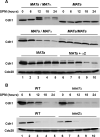This is a preprint.
APCCdh1-mediated degradation of Cdh1 is necessary for faithful meiotic chromosome segregation in S. cerevisiae
- PMID: 39005361
- PMCID: PMC11245022
- DOI: 10.1101/2024.07.01.601619
APCCdh1-mediated degradation of Cdh1 is necessary for faithful meiotic chromosome segregation in S. cerevisiae
Abstract
The Anaphase-Promoting Complex/Cyclosome (APC/C) is a ubiquitin ligase that promotes the ubiquitination and subsequent degradation of numerous cell cycle regulators during mitosis and in G1. Proteins are recruited to the APC/C by activator proteins such as Cdh1. During the cell cycle, Cdh1 is subject to precise regulation so that substrates are not degraded prematurely. We have explored the regulation of Cdh1 during the developmental transition into meiosis and sporulation in the budding yeast S. cerevisiae. Transition to sporulation medium triggers the degradation of Cdh1. Cdh1 degradation is mediated by the APC/C itself in a "trans" mechanism in which one molecule of Cdh1 recruits a second molecule of Cdh1 to the APC/C for ubiquitination. Degradation requires an intact glucose-sensing SNF1 protein kinase complex (orthologous to the mammalian AMPK nutritional sensor), which directly phosphorylates Cdh1 on Ser-200 within an unstructured N-terminal region. In the absence of phosphorylation, expression of a Cdh1-S200A mutant is fully stabilized, leading to chromosome instability and loss of viability. We hypothesize that Cdh1 degradation is necessary for the preservation of cell cycle regulators and chromosome cohesion proteins between the reductional and equational meiotic divisions, which occur without the intervening Gap or S phases found in mitotic cell cycles.
Figures






Similar articles
-
KEN-box-dependent degradation of the Bub1 spindle checkpoint kinase by the anaphase-promoting complex/cyclosome.J Biol Chem. 2007 Feb 9;282(6):3672-9. doi: 10.1074/jbc.M609376200. Epub 2006 Dec 11. J Biol Chem. 2007. PMID: 17158872
-
The regulation of Cdc20 proteolysis reveals a role for APC components Cdc23 and Cdc27 during S phase and early mitosis.Curr Biol. 1998 Jun 18;8(13):750-60. doi: 10.1016/s0960-9822(98)70298-2. Curr Biol. 1998. PMID: 9651679
-
The HECT type ubiquitin ligase NEDL2 is degraded by anaphase-promoting complex/cyclosome (APC/C)-Cdh1, and its tight regulation maintains the metaphase to anaphase transition.J Biol Chem. 2013 Dec 13;288(50):35637-50. doi: 10.1074/jbc.M113.472076. Epub 2013 Oct 25. J Biol Chem. 2013. PMID: 24163370 Free PMC article.
-
Regulation of APC/C activators in mitosis and meiosis.Annu Rev Cell Dev Biol. 2008;24:475-99. doi: 10.1146/annurev.cellbio.041408.115949. Annu Rev Cell Dev Biol. 2008. PMID: 18598214 Free PMC article. Review.
-
Mitotic regulation of the anaphase-promoting complex.Cell Mol Life Sci. 2007 Mar;64(5):589-600. doi: 10.1007/s00018-007-6443-1. Cell Mol Life Sci. 2007. PMID: 17334950 Free PMC article. Review.
References
Publication types
Grants and funding
LinkOut - more resources
Full Text Sources
Miscellaneous
